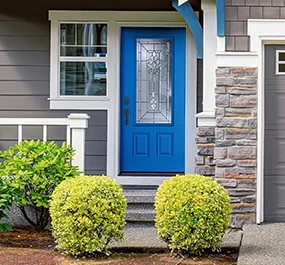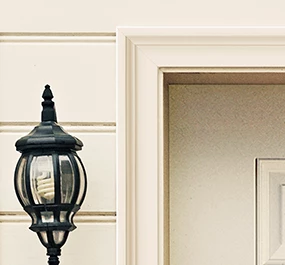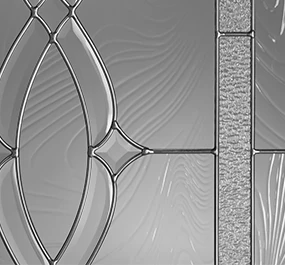Safety is one of the most important aspects of making you and your family feel at home. Doors are often thought of as one of the first lines of defense, especially when it comes to taking preventative measures against fires. This makes fire-rated residential doors an important consideration for home safety, as these doors offer protection from the spread of fire and smoke and extra time to escape.
We’ll cover how fire-rated doors are constructed, the protection they provide, and Plastpro’s line of fire-rated, residential doors. It should be noted that the information provided pertains specifically to the U.S. and Canada—those in other markets should consult local regulations.
Taking a look at fire-rated residential doors ratings
Fire doors are available in varying levels of protection, broken down by intervals of time—generally 20 minutes, 45 minutes, and 60 minutes. These ratings indicate how many minutes of protection the door provided in a test environment. This is an important distinction, as the door may perform differently in an organic situation—the rating is not intended to be an exact measure of performance
Code requirements will vary by geographic location and residential building type (single-family or multifamily)—both in terms of minute requirements and the placement of a fire-rated door. It’s best to consult with a professional and review your local requirements to ensure you are meeting any necessary specifications. In residential buildings, the most common placement of fire-rated doors is in entryways, corridors, and at the access point between garage and house.
Plastpro’s 20 Minute Fire Rated Residential Door kept this customer’s home safe for over two hours while firefighters worked to control a garage fire. Pictured is the door side facing the fire (left) compared to the interior of the door (right). Images taken by Dabbert Custom Homes.
Requirements of a fire-rated residential door and entryway
To comply with fire codes and standards, fire-rated doors are often made with steel or fiberglass material. Fire-rated residential doors are designed to confine fires to a certain area of a residential building and prevent fire and smoke from spreading throughout an entire house or complex. These doors are rated to provide a specific Fire Resistance Level (FRL), which tests structural adequacy, structural integrity, and insulation.
Wood, steel, and fiberglass doors can all be fire-rated. And while the structure of the door slab plays an important role in fire rating, the entryway as a whole must meet certain specifications to meet fire rating requirements. In addition to the door slab, the door jamb, hardware, and all other components of the entryway must be individually certified as fire-rated. The door unit as a whole must also be labeled as fire-rated. The National Fire Protection Association 80 outlines the requirements for a fire-rated entryway, including:
- No open holes in the door or the frame
- The door, frame, and hardware are secure and free of damage
- No hardware is installed that restricts operation of the door
An important part of fire-rating is also how well the door is sealed, as this will work to prevent smoke from clearing the entryway. Fire-rated residential doors will have an intumescent strip, which expands in the presence of heat, as well as the proper gaskets and weatherstripping in place. It should also be noted that if the door contains a window, the glass must be individually fire-rated as well.
Testing for fire-rated residential doors
Fire-rated residential doors undergo a series of tests to achieve their rating. Most notably is the endurance test, which measures the door’s ability to withstand heat over a certain period of time, hence the various minute ratings. The door is exposed to heat up to 1925 degrees Fahrenheit for up to 180 minutes. The door is measured on how long it stays intact within the frame with no openings.
Additional tests include the hose stream test, which measures the door’s ability to withstand a fire hose from 20 feet away. Doors with a 20-minute rating are exempt from this test in the US—however, the test is required for all ratings in Canada. Doors may also undergo the temperature rise test, which measures the door’s ability to control heat transfer from the fire side to the non-fire side over the first 30 minutes of the endurance test. Temperature rise ratings range from 250 to 650 degree Fahrenheit.
Plastpro’s selection of fire-rated residential doors and door frames
Plastpro’s Fire Rated Series doors are an excellent choice to bring additional safety to your home. As our fire-rated doors are made with fire-resistant composite, they comply with safety standards and will offer a minimum of 20 minutes of protection. Plastpro also offers options that will provide 60 minutes of protection, depending on your or your building’s safety needs, as well as models that pass the hose stream test, ensuring compliance in the Canadian market. For ultimate protection, Plastpro’s fire-rated doors pair perfectly with our PF Door Frames. These fireproof composite door frames, tested for single-unit homes, feature a certified 20-minute protection rating.
While fire-rated doors are required, and thus generally more common, in commercial buildings, the benefits they provide against fire and smoke make them a great overall choice for protecting single-family homes, loved ones, and belongings. And better yet—you don’t have to sacrifice the style you want. Fire-rated residential doors, including those from Plastpro, are available in a variety of styles to suit your individual needs.
Check out Plastpro’s Where to Buy page to find the closest distributor for fire-rated fiberglass doors. For more information on our fiberglass door offerings, visit our website.



